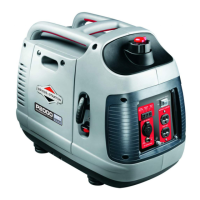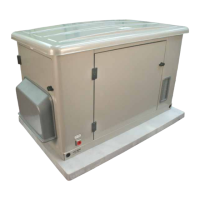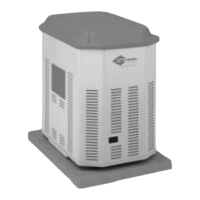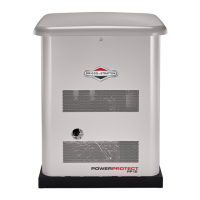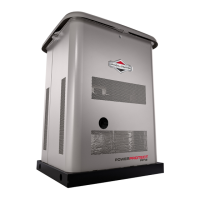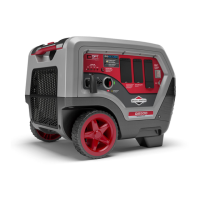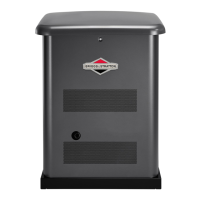17
Generator Maintenance
Generator maintenance consists of keeping the unit
clean and dry. Operate and store the unit in a clean dry
environment where it will not be exposed to excessive
dust, dirt, moisture, or any corrosive vapors. Cooling
air slots in the generator must not become clogged
with snow, leaves, or any other foreign material.
NOTICE DO NOT use water or other liquids to clean
generator. Liquids can enter engine fuel system,
causing poor performance and/or failure to occur. In
addition, if liquid enters generator through cooling air
slots, some of the liquid will be retained in voids and
cracks of the rotor and stator winding insulation. Liquid
and dirt buildup on the generator internal windings will
eventually decrease the insulation resistance of these
windings.
Cleaning
Daily or before use, look around and underneath
the generator for signs of oil or fuel leaks. Clean
accumulated debris from inside and outside the
generator. Keep the linkage, spring and other engine
controls clean. Keep the area around and behind
the muffler free from any combustible debris. Inspect
cooling air slots and openings on generator. These
openings must be kept clean and unobstructed.
Engine parts should be kept clean to reduce the risk of
overheating and ignition of accumulated debris:
• Use a damp cloth to wipe exterior surfaces clean.
NOTICE
Improper treatment of generator could
damage it and shorten its life.
• DO NOT expose generator to excessive moisture, dust,
dirt, or corrosive vapors.
• DO NOT insert any objects through cooling slots.
• Use a soft bristle brush to loosen caked on dirt or
oil.
• Use a vacuum cleaner to pick up loose dirt and
debris.
Cleaning Fuel Strainer
The fuel strainer helps prevent debris from entering the
fuel system.
Clean the fuel strainer as follows:
1. Make sure generator is on a level surface.
2. Remove the fuel cap (A) and fuel strainer (B).
3. Wash fuel strainer in liquid detergent and water.
4. Wipe fuel strainer clean with a clean, dry cloth.
5. Carefully reinstall the fuel strainer and fuel cap.
Engine Maintenance
Oil
Oil Recommendations
We recommend the use of Briggs & Stratton Warranty
Certified oils for best performance. Other high-quality
detergent oils are acceptable if classified for service SF,
Outdoor temperatures determine the proper oil viscosity
for the engine. Use the chart to select the best viscosity
for the outdoor temperature range expected.
* Below 40°F (4°C) the use of SAE 30 will result in hard starting.
** Above 80°F (27°C) the use of 10W30 may cause
increased oil consumption. Check oil level more frequently.
B
A
WARNING Unintentional sparking could cause
fire or electric shock resulting in
death or serious injury.
WHEN ADJUSTING OR MAKING REPAIRS TO YOUR
GENERATOR
• Disconnect the spark plug wire from the spark plug and
place the wire where it cannot contact spark plug.
WHEN TESTING FOR ENGINE SPARK
• Use approved spark plug tester.
• DO NOT check for spark with spark plug removed.

